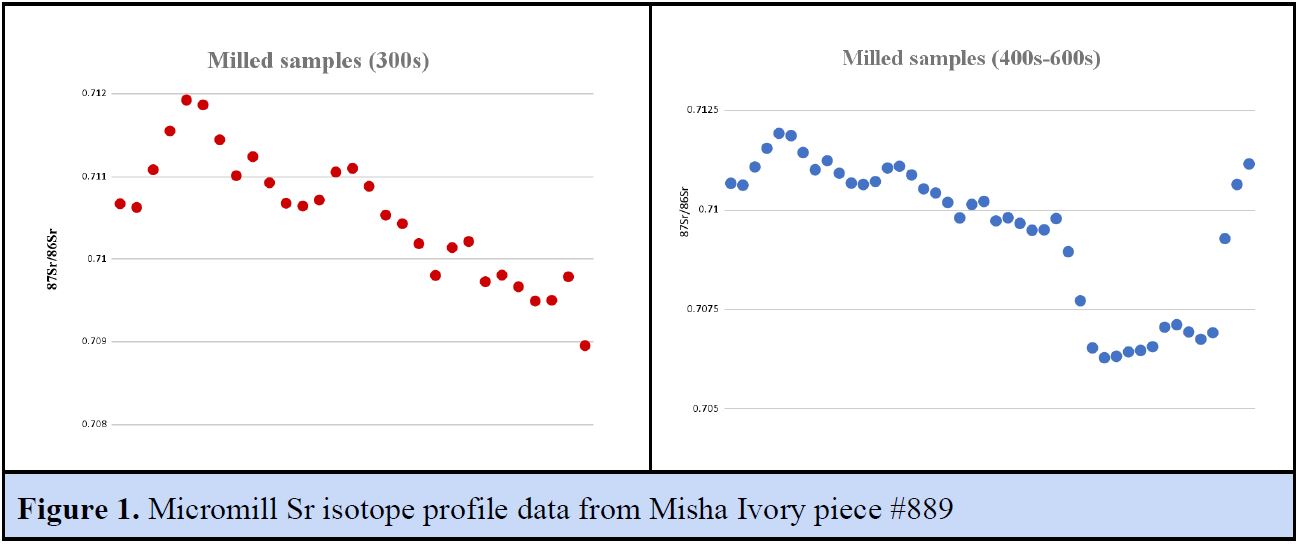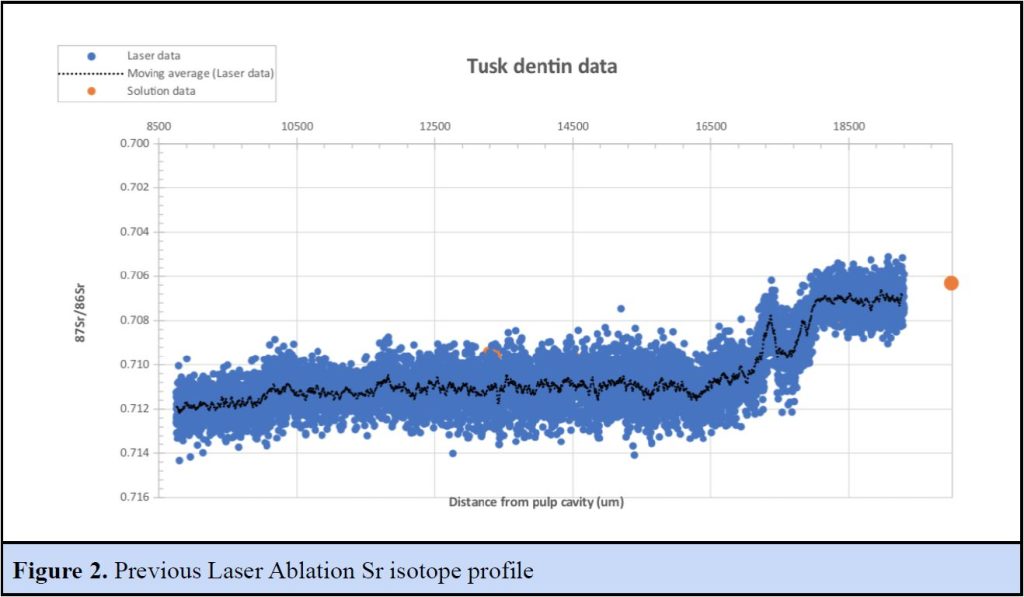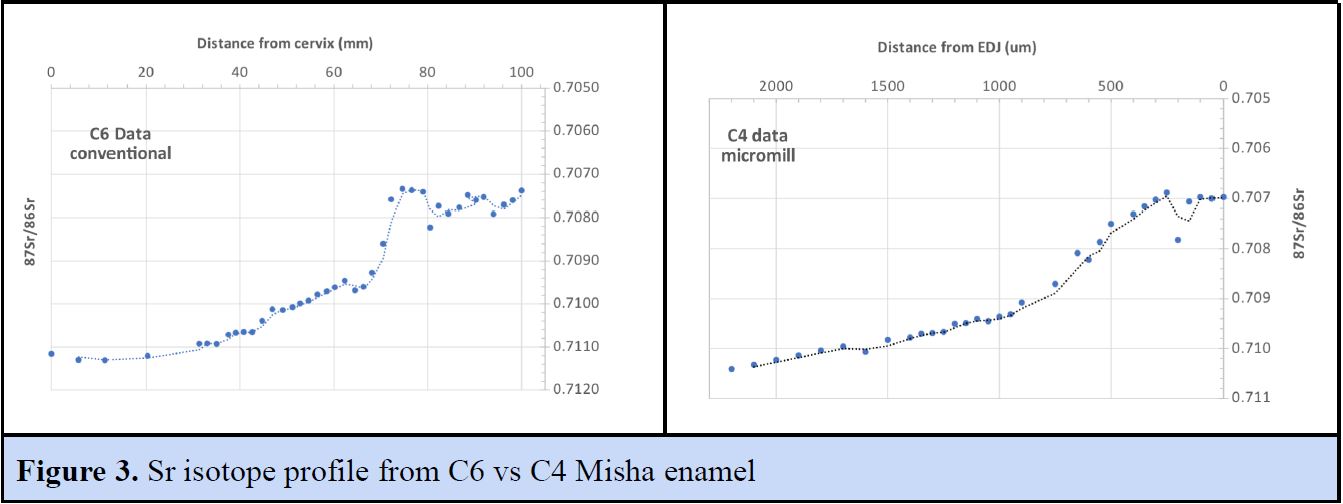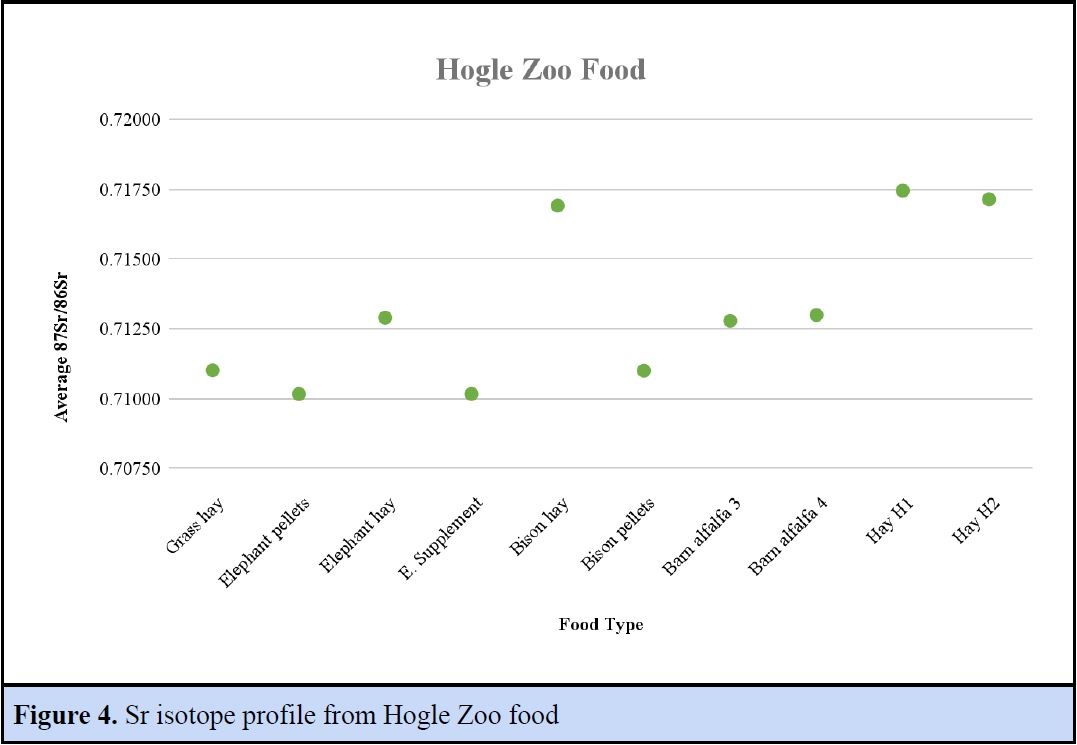Mines & Earth Sciences
84 An Individual Migration Story: Comparing Strontium Isotope Analysis in Enamel, Ivory, and Food Sources From A Single Modern Elephant
Katya Podkovyroff and Diego Fernandez (Geology and Geophysics)
Faculty Mentor: Diego Fernandez (Geology and Geophysics, University of Utah)
Abstract
Reconstructions of paleoclimate and paleoecology using stable isotopes of carbon, oxygen and strontium have become fairly common in many areas of the world. Focusing on strontium (Sr) isotope analysis, this project directly contributed to the collection, processing and data configuration of elephant ivory and molar samples as well as food eaten by said elephant. Misha, an elephant from the Salt Lake City Hogle Zoo, had previously been living in California and then was moved to Utah. To follow this migration, ivory, enamel, and food samples were analyzed to determine Sr isotopic composition. This data encapsulates the complexity and abilities in stable isotope analysis for migration research.
Introduction
The fields of archaeology and geochemistry have used stable isotope analysis for reconstructions of paleodiets and other prehistoric behaviors since the 1970s. These processes have been used as evidence for topics such as human evolution, migration research, transitions to agriculture, among other topics (Cerling et al., 2015; Eerkens, 2015). In particular, stable isotope analysis of tooth enamel, bone, and ivory has emerged as a powerful tool for migration research of living and fossil animals (Zazzo et al., 2012; Wooller et al., 2021; Lazzerini et al., 2021). As such, isotopic variations of mammalian tooth enamel, particularly in carbon, oxygen, and strontium, can be further studied to analyze variations in these migration patterns, climate and diet as a means of further understanding archaeological questions as well as modern mammals (Reade et al., 2015; Zazzo et al., 2012). An ivory tusk is a modified upper incisor that forms incrementally throughout the lifetime of an elephant both in length and girth. Therefore one of the greatest difficulties with ivory is assessing the non-homogenous incremental tissues and differences in turnover. For example, the earliest formed or distal end of the tusk is used in an elephant’s daily activities and can be worn away throughout their lifetime whereas the proximal end is the most recently formed part of the tusk (Coutu et al., 2016). Understanding the growth rate of elephant tusks is certainly important for sampling methods but a critical part of understanding the bigger picture is obtaining multiple tissue samples from the same specimen, such as enamel from a molar. Mammalian tooth enamel forms incrementally from the top to the base of the tooth with isotope analysis being attributed to measuring diet (δ13C) and tracking water sources (δ18O) during tooth mineralization (Wang & Cerling, 1994). Focusing on tooth enamel has allowed researchers to avoid any diagentic alteration damage since this tissue has high resistance to such a process (Wang & Cerling, 1994). 87Sr/86Sr reflects the bedrock strontium that is made available in soils to plants. Therefore, this bioavailable strontium is affected by the extent and type of weathering that occurs from the bedrock to soil which can be ultimately detected in the enamel or ivory samples of organisms (Coutu et al., 2016). As such, isotopic variations of tooth enamel or ivory can be used to create isoscapes of geographic regions as well as further studied to analyze variations in migration patterns, climate and diet as a means of further understanding archaeological questions as well as modern mammals (Reade et al., 2015; Zazzo et al., 2012). Furthermore, evaluating these isotopic measurements requires a fundamental understanding as to how these elemental compositions within organisms can indicate correlation between seasonality and the elemental abundance in a given environment via the elemental signature (Koch, 1989).
Methods
Sample Collection
Ivory: The ivory samples were collected using a micromilling device from Ivory piece #889. Four sets of samples were collected, identified as the 300s and 400s-600s series. The 300s samples milling settings were as follows: 50 μm depth-per-pass, 5 pass count, 250 μm/sec scan speed, 25 μm/sec plunge speed, and the length of sample taken per measurement was 10 mm. The 400-600s samples milling settings were as follows: 100 μm depth-per-pass, 5 pass count, 250 μm/sec scan speed, 25 μm/sec plunge speed, and the length of sample taken per measurement was 20.8 mm.
Enamel: The molar samples were already collected with a distinction of two techniques: C4 (micromill from Misha Rm3.5b enamel) vs C6 (conventionally sampled from Misha_Rm3.5 enamel).
Food: Food was provided in paper envelopes and labeled with contents.
Elemental Analysis of Trace and Major Elements
Ivory, Enamel, Food: All samples were diluted by a factor of 50, using the recipe 20 μL digest + 10 μL Indium Standard + 970 μL 2.4% 𝐻𝑁𝑂 directly into an autosampler plate. A calibration 3 curve was prepared from single-element standards (Inorganic Ventures, Christianburg, VA, US), with indium added as internal standard. Diluted samples and calibration solutions were run in a triple quadrupole inductively coupled plasma mass spectrometer (ICPMS, Agilent 8900, Santa Clara, California, USA). Certified reference materials 1643f (Trace Elements in Water, National Institute of Standards and Technology, Gaithersburg, MD, US) was used as a control for data quality.
Sr Purification and 87Sr/86Sr determination
Ivory, Enamel, Food: Using the Sr concentration calculated from the elemental analysis, aliquots containing 200 ng of Sr in 2 M HNO3 (prepared by mixing sample digest + conc 𝐻𝑁𝑂 + water) 3 and run through an automated Sr-purification system (PrepFAST, ESI, Omaha, NE, US). Purified Sr fractions, contained in 6 M HNO3, were then dried down at 185 °C and redissolved with 1mL of 2.4% 𝐻𝑁𝑂 . These Sr fractions were used for isotopic analysis in a multicollector ICPMS 3 (Neptune, ThermoFinnigan, Breman, Germany). Certified reference material 987 (SrCO3, National Institute of Standards and Technology, Gaithersburg, MD, US) was used to monitor the accuracy of the method
Results
Figure 1 displays 87Sr/86Sr of the ivory tusk. Each ivory series was run separately and the transition from California to Utah is better seen in the combined 400-600 series, likely due to the increased number of samples collected. California 87Sr/86Sr values are seen on the lower values (as seen on the right of both 300 and 400 series graphs) and Utah 87Sr/86Sr are seen on the higher values (as seen on the left of both series graphs). Interestingly there are two humps on the graphs but the more prominent one is likely to be the transition from California to Utah. Likewise, the laser ablation Sr isotope profile as seen in Figure 2, the graph begins with the Utah values on the left and then can be seen seemingly increasing (although the values on the vertical axis are in descending order moving up).

Figure 1. Micromill Sr isotope profile data from Misha Ivory piece #889
 Enamel MC-ICP-MS was used in order to complete a Sr composition analysis of the enamel (as seen in Figure 3). The differences between the sample collection techniques are not stark and both show similar transition state values.
Enamel MC-ICP-MS was used in order to complete a Sr composition analysis of the enamel (as seen in Figure 3). The differences between the sample collection techniques are not stark and both show similar transition state values.

Food MC-ICP-MS was used in order to complete a Sr composition analysis of the food provided from the Hogle Zoo caretaker of the elephant (as seen in Figure 4). The sample types include grass hay, elephant hay, elephant pellets, elephant supplement (denoted as E. Supplement), bison hay, bison pellets, barn alfalfa, and other types of hay that were differentiated from the rest. Each sample was run twice and then the average was taken. The dates of when the food was used span from December 2000 to May 2012. Misha was moved to the Hogle zoo in April 2005 and died in September 2008.

Discussion and Future Results
Comparing the previously run tusk samples from the Laser-Ablation method done by Dr. Kevin Uno, former PhD student at the university, to the Dissolution method I completed, there was a confirmation of the previous results. Likewise, both the enamel analyses line up with one another as well as conceptually. When thinking of how samples were collected or presented, the distance from the pulp cavity of the molar was the innermost samples, where Utah data would be seen, versus moving to the outer regions which are older pieces of ivory that were formed when Misha was in California. Finally, the value of having this food data is to get an idea of how food intake can play a role in Sr isotope analysis, not just for carbon isotopes. In order to correct for mixing ratios of the food, an intake model will need to be made to evaluate how much Sr intake is being consumed by those food items.
Although this project is ongoing, the data collected up to this point is substantial. The immediate next steps include evaluating a molar sample from Misha and completing a Laser-Ablation Sr analysis to be compared to the other enamel data. The final product of this project will result in a comprehensive modeling of Sr turnover, the time it takes for an animal to switch values in Sr based on movement, which will be a major contribution to paleodiet research. Completing a multiple tissue, multiple method analysis of an animal that is relatively controlled as well as having data on the food the animal consumed can immensely assist in how to complete paleontology migration research in the future.
References
Cerling, T. E., Andanje, S. A., Blumenthal, S. A., Brown, F. H., Chritz, K. L., Harris, J. M., Hart, J. A., Kirera, F. M., Kaleme, P., Leakey, L. N., Leakey, M. G., Levin, N. E., Manthi, F. K., Passey, B. H., & Uno, K. T. (2015). Dietary changes of large herbivores in the Turkana Basin, Kenya from 4 to 1 Ma. Proceedings of the National Academy of Sciences, 112(37), 11467-11472.
Eerkens, J. W., Sullivan, K., & Greenwald, A. M. (2016). Stable isotope analysis of serial samples of third molars as insight into inter- and intra-individual variation in ancient diet. Journal of Archaeological Science: Reports, 5, 656–663. https://doi.org/10.1016/j.jasrep.2015.11.003
Higgins, P., & MacFadden, B. J. (2004). “Amount Effect” recorded in oxygen isotopes of Late Glacial horse (Equus) and bison (Bison) teeth from the Sonoran and Chihuahuan deserts, southwestern United States Palaeogeogr. Palaeoclimatol. Palaeoecol., 206 (3–4) (2004), pp. 337-353. https://doi.org/10.1016/j.palaeo.2004.01.011
Koch, P.L., Fisher, D. C., & Dettman, D (1989). Oxygen isotope variation in the tusks of extinct proboscideans: A measure of season of death and seasonality. Geology 1989;; 17 (6): 515–519. https://doi.org/10.1130/0091-7613(1989)017<0515:OIVITT>2.3.CO;2
Lazzerini, N., Balter, V., Coulon, A., Tacail, T., Marchina, C., Lemoine, M., Bayarkhuu, N., Turbat, Ts., Lepetz, S., & Zazzo, A. (2021). Monthly mobility inferred from isoscapes and laser ablation strontium isotope ratios in caprine tooth enamel. Scientific Reports, 11(1), 1-11.
Reade, H., Stevens, R. E., Barker, G., & O’Connell, T. C. (2015). Tooth enamel sampling strategies for stable isotope analysis: Potential problems in cross-method data comparisons. Chemical Geology, Volume 404, pp. 126-135. https://doi.org/10.1016/j.chemgeo.2015.03.026.
Wang, Y., & Cerling, T. E. (1994). A model of fossil tooth and bone diagenesis: Implications for paleodiet reconstruction from stable isotopes. Palaeogeography, Palaeoclimatology, Palaeoecology, 107(3-4), 281–289. https://doi.org/10.1016/0031-0182(94)90100-7
Wooller, M. J., Bataille, C., Druckenmiller, P., Erickson, G. M., Groves, P., Haubenstock, N., Howe, T., Irregeher, J., Mann, D., Moon, K., Potter, B. A., Prohaska, T., Rasic, J., Reuther, J., Shapiro, B., Spaleta, K. J., & Willis, A. D. (2021). Lifetime mobility of an Arctic woolly mammoth. Science, 373(6556), 806-808.
Zazzo, A., Bendrey, R., Vella, D., Moloney, A. P., Monahan, F. J., & Schmidt, O. (2012). A refined sampling strategy for intra-tooth stable isotope analysis of mammalian enamel. Geochimica Et Cosmochimica Acta, 84, 1–13. https://doi.org/10.1016/j.gca.2012.01.012

